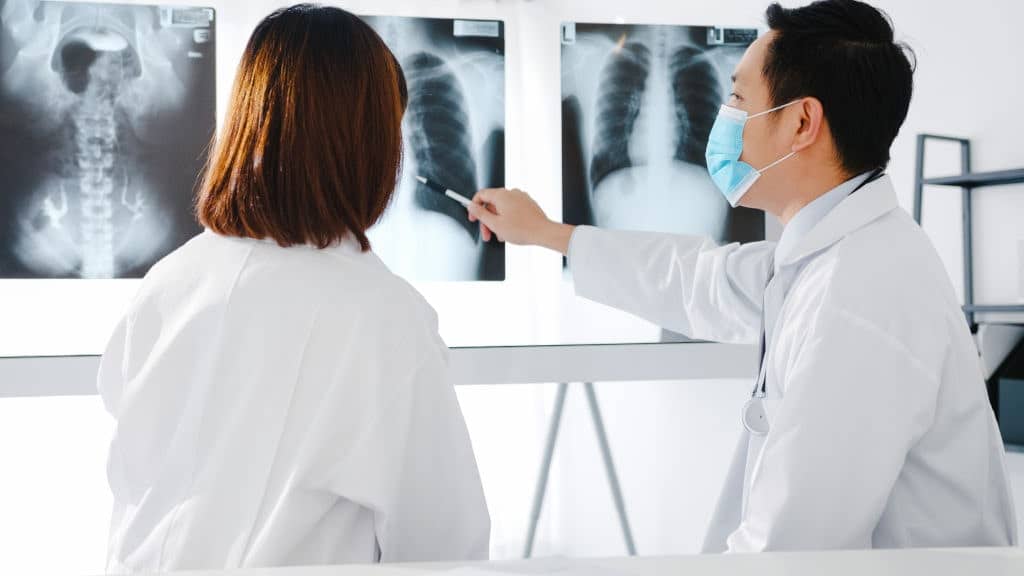Scoliosis is a condition in which the spine curves to one side. Any part of the spine can be impacted by curvature. However, the upper spine and lower back are the most frequently affected areas.
Although scoliosis is not usually noticeable, some victims may lean to one side. Others may have unequal shoulders or hips due to the spine’s curve.
Most of the time, the person does not require treatment because the curve frequently does not advance significantly. However, doctors might suggest a blend of back bracing and physical therapy depending on the severity of the curvature and the child’s age.
Scoliosis can have side effects, including breathing problems, chronic pain, and a decreased ability to exercise.
According to the American Association of Neurological Surgeons, scoliosis affects approximately six to nine million people in the United States or 2 to 3 percent of the population. Every year, over 600,000 scoliosis patients visit private medical clinics. An estimated 30,000 children are fitted with a brace, and 38,000 patients receive spinal fusion surgery.
Early childhood or infancy are potential times for scoliosis to manifest. However, scoliosis often develops between the ages of 10 and 15 in both sexes equally.
Suppose a medical practitioner fails to rightly diagnose scoliosis or negligently performs a spinal fusion surgery on a patient. In that case, medical animation can portray medical malpractice in the courtroom.
Types of Scoliosis Malpractice Cases
Scoliosis malpractice can have debilitating effects on a person. A victim may be able to receive compensation if they or a loved one has suffered from this injustice.
Here are the types of scoliosis malpractice cases:
- Scoliosis diagnosis
When a doctor fails to recognize a condition like scoliosis, the patient bears the brunt of the consequences. They may have to deal with back pain, migraines, and other physical conditions for the rest of their lives. Some patients are left in circumstances with no apparent hope of recovery.
In fact, doctors and other healthcare professionals may skip ordering an x-ray in favor of prescribing medicine to relieve the patient’s back discomfort.
By delaying therapy, the patient frequently misses the window of time during which medical treatments for treating scoliosis would have been helpful, which is usually during the younger years.
Instead, one is made to endure worsening pain and suffering, time away from work, missed opportunities for the future due to career restrictions, and much more.

- Negligent surgery
Spinal surgery is a somewhat risky procedure by nature. Since the spinal cord is involved, operating near it entails a severe risk. It can lead to results like death, paralysis, loss of bowel or bladder control, or loss of sexual function.
There are several situations when spinal surgical negligence may occur in a case of scoliosis.
They include not adequately determining a patient’s suitability for surgery, performing unneeded surgery owing to a misdiagnosis, and errors made during the surgery, such as in a scoliosis repair procedure.
They also include failing to tell the patient of the significant dangers of the surgery or any other therapies available. Anesthesia mistakes, failure to monitor the patient during surgery properly, tracking errors after the operation, or not referring a patient for postoperative care (e.g., physiotherapy) are also other circumstances.
How To Use Medical Animation In Scoliosis Malpractice Cases
To establish negligence in the context of scoliosis medical care in the US, a plaintiff must show that the defendant owed the plaintiff a duty to treat them per the accepted standard of care- which is the level of care that an expert in the defendant’s field would provide in a comparable circumstance.
The next step is for the plaintiff to prove that the defendant deviated from the standard.
A violation of the standard can occur. For instance, if the defendant failed to order x-rays after noticing evidence of scoliosis in a patient, even if a reasonable doctor would have done so.
Medical animation can be used to prove that there was a deviation from the standard measure. It can showcase standard procedure and the variation from the accepted treatment norm.
The plaintiff must also show that the damages were caused and are genuine.
In other words, the plaintiff must demonstrate that actual harm resulted from the defendant’s failure to diagnose scoliosis or negligent medical procedure. Therefore, even though the defendant failed to diagnose the plaintiff or performed negligent surgery, the plaintiff is not entitled to damages unless there is evidence that the delayed diagnosis had unfavorable effects.
The judge or jury will typically need to hear from a medical expert. The expert will describe the applicable standard of care and how the defendant’s acts or inactions deviate from that standard.
For instance, in the Washington case of Emily v. Thomas. In this case, the plaintiff was harmed during a scoliosis surgery procedure and suffered excruciating pain that was so horrible she passed out at its intensity. The defendant’s negligence lies in his operation on the plaintiff under the influence of benzodiazepine and an unspecified narcotic.
The plaintiff was later awarded $ 1 million for pain and suffering and $219,052 for her past medical expenses.
In proving the unfavorable effect of scoliosis malpractice, as seen in the case above, a demonstrative exhibit like medical malpractice trial animation can be used to illustrate the pain patterns the victim is passing through due to the defendant’s malpractice.
In addition, an error during a procedure like spinal fusion surgery aimed at correcting scoliosis can be illustrated.
Conclusion
Scoliosis is a harrowing and deforming condition that can be avoided if appropriate medical attention is sought to alleviate the problem. Medical animators at Fox-AE are capable of illustrating a spine with and without scoliosis to show the difference.
Should malpractice occur during a spinal fusion surgery needed to treat a case of scoliosis, our team of expert medical animators can illustrate the procedure and errors during the procedure.
Our processes and structure at Fox-AE are clear and straightforward. We work with expert witnesses and attorneys on the case to ensure that our illustration is all-inclusive. Hence, meticulously representing the facts and opinions of experts on the case.





